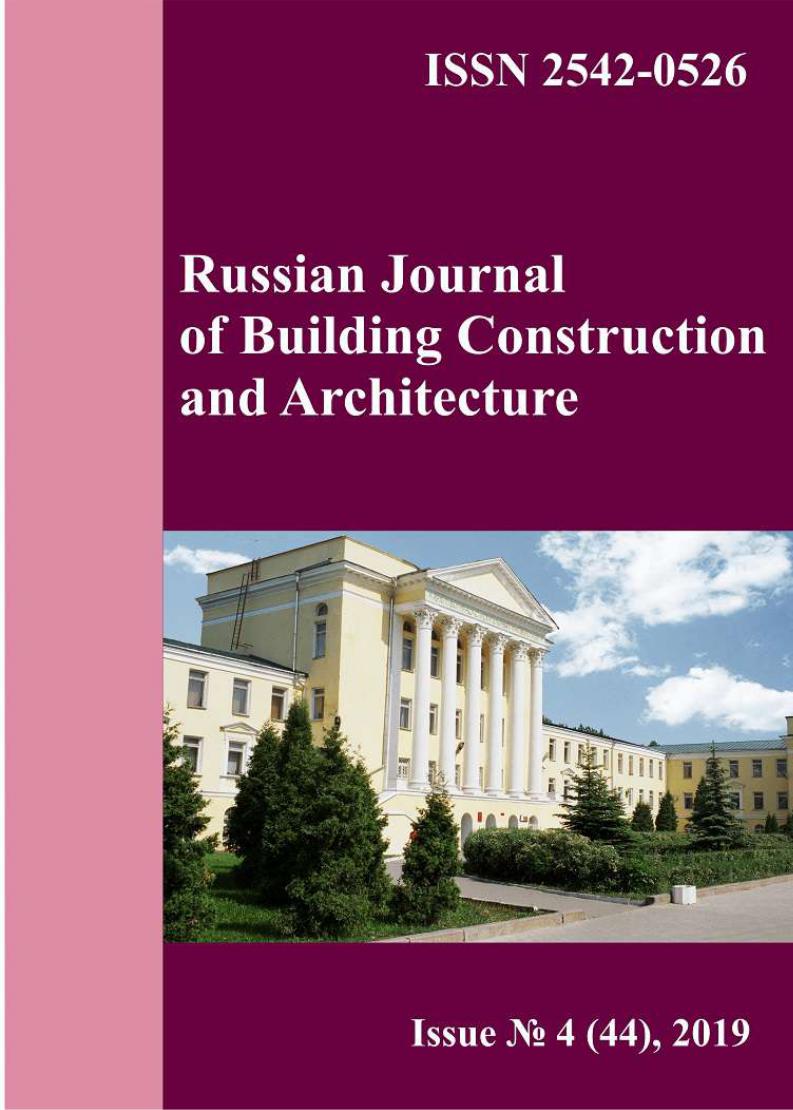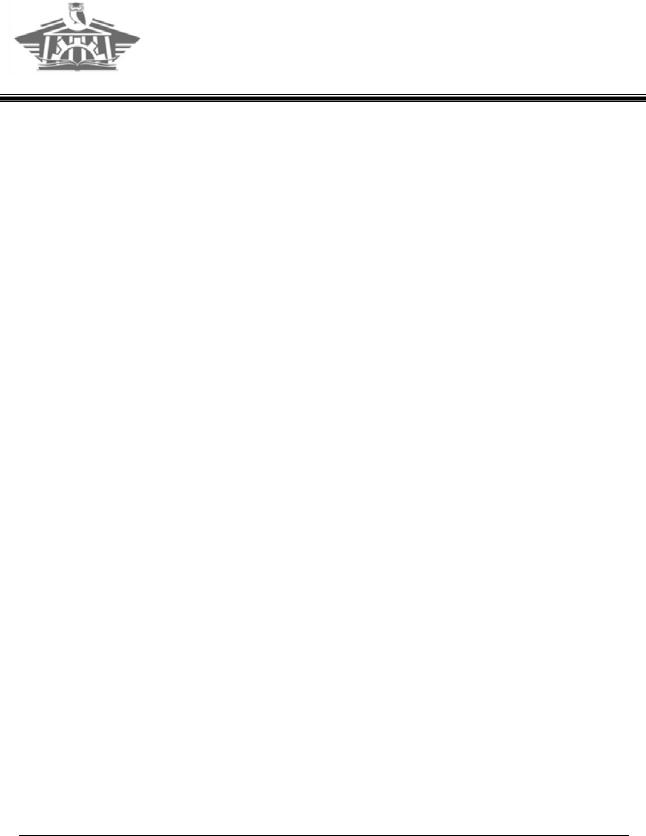
Russian Journal of Building Construction and Architecture
.pdf
RUSSIAN JOURNAL
OF BUILDING
CONSTRUCTION AND ARCHITECTURE
1

The journal is indexed/abstracted in:
Web of Science Core Collection
(Emerging Sources Citation
Index)
(Thomson Reuters), USA
Ulrich's Periodicals Directory
(Bowker), USA,
DOAJ
(Lund University), Sweden,
Academic Search Complete
(EBSCO), USA,
SOCOLAR
(China Educational Publications Import and Export Corporation –– CEPIEC), China,
Google Scholar
(Google), USA,
E-Library
(ООО «РУНЭБ»), Russia,
J-Gate
(Informatics Ltd), India
2
ISSN 2542-0526
RUSSIAN JOURNAL
OF BUILDING
CONSTRUCTION AND ARCHITECTURE
N 4 (44)
BUILDING STRUCTURES, BUILDINGS AND CONSTRUCTIONS
BASES AND FOUNDATIONS, UNDERGROUND STRUCTURES
HEAT AND GAS SUPPLY, VENTILATION, AIR CONDITIONING, GAS SUPPLY AND ILLUMINATION
BUILDING MATERIALS AND PRODUCTS
TECHNOLOGY AND ORGANIZATION OF CONSTRUCTION
DESIGNING AND CONSTRUCTION OF ROADS, SUBWAYS, AIRFIELDS, BRIDGES AND TRANSPORT TUNNELS
BUILDING MECHANICS
THEORY AND HISTORY OF ARCHITECTURE, RESTORATION AND RECONSTRUCTION OF HISTORICAL
AND ARCHITECTURAL HERITAGE
ARCHITECTURE OF BUILDINGS AND STRUCTURES. CREATIVE CONCEPTIONS OF ARCHITECTURAL ACTIVITY
CITY PLANNING, PLANNING OF VILLAGE SETTLEMENTS
Voronezh 2019
3

Russian Journal
of Building Construction and Architecture
Periodical scientific edition
Published since 2009 |
Comes out 4 times per annum |
Founder and publisher: Federal State Education Budget Institution of Higher Professional Education «Voronezh State Technical University».
The articles are reviewed and processed with the program ANTIPLAGIARISM. This publication cannot be reprinted without the prior permission of the publisher, references are obligatory.
Number of the certificate of registration of the media ПИ № ФС 77-67855 Issued by the Federal Service for Supervision of Communications, Information Technology,
and Mass Media (Roskomnadzor)
Price is subject to change
EDITORIAL COUNCIL
The Head of the Council: Kolodyazhny S. A., D. Sc. in Engineering, rector (Voronezh State Technical University)
EDITORIAL BOARD
Editor-in-Chief: Melkumov V. N., D. Sc. in Engineering, Prof.
(Voronezh State Technical University)
Members:
Boldyrev А.М., Corresponding Member of the Russian Academy of Architecture and Engineering Science, D.Sc. in Engineering, Prof., Voronezh State Technical University, Russia
Bondarev B. А., D. Sc. in Engineering, Prof., Lipetsk State Technical University, Russia
Gagarin V. G., Corresponding Member of RAABS, Moscow State University of Civil Engineering, Russia
Gelfond А. L., Corresponding Member of the Russian Academy of Architecture and Construction Science, D. Sc. in Architecture, Nizhniy Novgorod State University of Architecture and Construction, Russia
Enin A. Ye., PhD in Architecture, Prof., Voronezh State Technical University, Russia
Karpenko N. I., Academician of RAABS, Research Institute of Building Physics (NIISF RAABS), Russia
Kirsanov М.N., D.Sc. in Physics and Mathemat-
ics, Professor (National Research University “Moscow Power Engineering Institute”)
Kobelev N. S., D. Sc. in Engineering, Prof., Southwest State University, Kursk, Russia
Kolchunov V. I., Academician of RAABS, Southwest State University, Kursk, Russia
Ledenyev V. I., D. Sc. in Engineering, Prof., Tambov State Technical University, Russia
Lyahovich L. S., Academician of RAABS, Tomsk State University of Architecture and Building, Russia
Mailyan L. R., D. Sc. in Engineering, Prof., Don State Technical University, Rostov, Russia
Panibratov Yu. P., Academician of RAABS, Saint Petersburg State University of Architecture and Civil Engineering, Russia PodolskyVl.P.,D.Sc. in Engineering, Prof.,Voronezh State Tech-
nical University, Russia (Dep. of the Editor-in-Chief)
SlavinskayaG.V.,D. Sc. in Chemistry, Prof, Voronezh State Technical University, Russia
SuleymanovА.М.,D. Sc. in Engineering, Prof.,Kazan State University of Architecture and Engineering, Russia
Fyedorov V. S., Academician of RAABS, Moscow State University of Railway Engineering, Russia
Fedosov S. V., Academician of RAABS, Ivanovo State Polytechnic University, Russia
Chernyshov Ye. M., Academician of RAABS, Voronezh State Technical University, Russia
Shapiro D. M., D. Sc. in Engineering, Prof.,Voronezh State Technical University, Russia
Shubenkov М. V., Academician of the Russian Academy of Architecture and Construction Science, D. Sc. in Architecture, Prof., Моscow Institute of Architecture (State Academy), Russia Asanowicz Alexander, Prof., Dr. of Sn., Technical University of Bialystok, Poland
Figovsky Oleg L., Prof., Dr. of Sn., Member of EAS, Israel Korsun V. I., D. Sc. in Engineering, Prof., The Donbas National Academy of Civil Engineering and Architecture, Ukraine Nguyen Van Thinh, Prof., Dr. of Sn., Hanoi University of Architecture, Vietnam
Editor: Kotlyarova E. S. |
Translator: Litvinova O. A. |
THE ADDRESS of EDITORIAL AND THE PUBLISHER OFFICE:84 20-letiya Oktyabrya str., Voronezh, 394006, Russian Federation Tel./fax: (473)2-774-006; e-mail: vestnik_vgasu@mail.ru
Publication date 15.11.2019. Format 60×84 1/8. Conventional printed sheets 14,4. Circulation 500 copies. Order 217.
Published in Printing Office of Voronezh State Technical University 84 20-letiya Oktyabrya str., Voronezh, 394006, Russian Federation
ISSN 2542-0526 |
© Voronezh State Technical |
|
University, 2019 |
4
CONTENTS |
|
BUILDING STRUCTURES,BUILDINGS AND CONSTRUCTIONS ................................................... |
6 |
Fedorov V. S., Kolchunov Vl. I., Pokusaev A. A., Naumov N. V. |
|
Calculation Models of Deformation of Reinforced Concrete Constructions |
|
with Spatial Cracks..................................................................................................................... |
6 |
BUILDING MATERIALS AND PRODUCTS.................................................................................. |
28 |
Dehghanpour Heydar, Yılmaz Kemalettin |
|
Evaluation and Investigation of Waste Glass Aggregates and Powders |
|
in Architectural Mortars........................................................................................................... |
28 |
DESIGNING AND CONSTRUCTION OF ROADS,SUBWAYS, |
|
AIRFIELDS,BRIDGES AND TRANSPORT TUNNELS................................................................... |
43 |
Borisenko Yu. G., Kazaryan S. O. |
|
Features of the Stress Strain of Ceramsite Powder Modified SMA Pavements...................... |
43 |
Nguyen Van Long, Matvienko F. V., Nguyen Duc Sy |
|
The Study of Deformation Stability of Asphalt Concrete Modified |
|
with an Additive Tafpack-Premium......................................................................................... |
51 |
Uglova Ye. V., Tiraturyan A. N., Shiloh O. A. |
|
Prediction of Failure Fatigue Accumulation in Asphalt Concrete Layers |
|
of Flexible Pavements.............................................................................................................. |
60 |
BUILDING MECHANICS............................................................................................................ |
70 |
Yeremin V. G., Kozlov A. V. |
|
Analytical Dependence of the Shift from The Shear Stiffness of the Seam Between |
|
the Concrete Slab and Steel Beam........................................................................................... |
70 |
Kositsyn S. B., Fedorov V. S., Akulich V. Yu., Kolchunov V. I. |
|
Numerical Analysis of a Cylindrical Shell and Soil Considering Changes |
|
in a Computational Model Over Time..................................................................................... |
82 |
ARCHITECTURE OF BUILDINGS AND STRUCTURES. |
|
CREATIVE CONCEPTIONS OF ARCHITECTURAL ACTIVITY ................................................... |
92 |
Podolskaya L. V. |
|
Development Scenarious of Artistic Interior Design in the Historical Perspective. |
|
an Individual Approach to Design ........................................................................................... |
92 |
CITY PLANNING,PLANNING OF VILLAGE SETTLEMENTS.................................................... |
103 |
Grosheva T. I. |
|
Theoretical Foundations and Practice of Reconstruction |
|
of Landscape-Recreational Spaces......................................................................................... |
103 |
INSTRUCTIONS TO AUTHORS................................................................................................. |
121 |
5

Russian Journal of Building Construction and Architecture
BUILDING STRUCTURES,BUILDINGS AND CONSTRUCTIONS
DOI 10.25987/VSTU.2019.44.4.001
UDC 624.012.45
V. S. Fedorov 1, Vl. I. Kolchunov 2, A. A. Pokusaev 3, N. V. Naumov 4
CALCULATION MODELS OF DEFORMATION OF REINFORCED CONCRETE
CONSTRUCTIONS WITH SPATIAL CRACKS
Russian University of Transport (RUT) (MIIT)
Russia, Moscow 1, 3
Southwest State University (SWSU)
Russia, Kursk 2, 4
1 Academician of the RAACS, D. Sc. in Engineering, Prof.,
Head of the Department of Structures, Buildings and Facilities, e-mail: fvs_skzs@mail.ru
2 D. Sc. in Engineering, Prof. of the Department of Unique Building and Structures, e-mail: vlik52@mail.ru 3 PhD student of the Department of Structures, Buildings and Facilities
4 PhD student of the Department of Unique Building and Structures, e-mail: lich1992@hotmail.com
Statement of the problem. A model of deformation of reinforced concrete structures with spatial cracks is proposed.
Results. In the article working prerequisites are presented and the determining equations of the model of the resistance of reinforced concrete structures to torsion with bending are derived. Conclusions. Methods for calculating the resistance of reinforced concrete structures, as well as calculating the distance between spatial cracks and the width of crack opening under the joint action of the bending moment, torque and lateral force in the second stage of the stress-strain state are considered for two cases (case 1 –– when the spatial cracks of the first type appear on the lower edge of the reinforced concrete structure, case 2 –– when the spatial cracks of the first type appear on the lateral edge of the reinforced concrete structure).
Keywords: calculation method, torsion with bending, stress – strain, reinforced concrete structures, spatial crack.
Introduction. Resistance of spatial sections of ferroconcrete structures is regarded as complex if apart from bending moments and transverse forces, a structure is affected by rolling moments. They cause spiral cracking in ferroconcrete structures that form a spatial section inside three faces of an element along with a compressed area in the fourth face isolating it.
© Fedorov V. S., Kolchunov Vl. I., Pokusaev A. A., Naumov N. V., 2019
6
Issue № 4 (44), 2019 |
ISSN 2542-0526 |
Designing calculation models for complex resistance and bending rolling is gaining momentum [1, 2]. Firstly, there have been few studies on the topic [3––10]. Secondly, there is a growing need for analyzing spatial operation of a vast majority of ferroconcrete structures that are causing major transformations in modern cities [13––15]. Thirdly, it is known for a fact that there is nothing more practical than coming up with a solid theory for calculating them [16––23].
The current guidelines [12] for calculating operation of bending rolling suggest rather complicated and elaborate formulas. Despite the fact that these guidelines do not take into consideration the effect of a complex stress-strain on strain stress in compressed concrete Rb. Therefore it is not only the viability of the solution that is lost but its essential accuracy as well.
In the paper by А. S. Zalesov [8] a major step was taken towards identifying an equilibrium equation for the problem which was written for longitudinal and transverse planes, which makes calculation formulas considerably easier compared to those specified in the guidelines. Axial efforts in the transverse reinforcement in the side faces of an element are given consideration (the guidelines only specify efforts in the reinforcement near the face). However, the deformation equations of a spatial section used here and replacing it with a simplified diagonal one have not been proved in a number of experiments. Assuming longitudinal strains in the compressed zone of concrete to equal Rb has no substantial reason for a complex stressstrain of the zone while determining the projection of a dangerous spatial crack the condition of a minimum function of a lot of variables, etc. is not used.
In this paper the authors propose a calculation method which was not found to have any of the above disadvantages.
1. Solid considerations for a model of resistance of ferroconcrete structures to bending rolling. The following calculation considerations were made for the suggested method:
––a spatial crack on the lower face of a ferroconcrete element occurs perpendicularly to the main deformations of concrete lengthening and direction of the end of the spatial crack front near the compressed face of a ferroconcrete element coincides with that of main deformations of concrete shortening. Therefore a spatial crack has a spiral shape with three possible schemes of the compressed zone –– Fig. 1;
––a calculated scheme is the one consisting of a support block (formed by a spatial crack and a vertical section passing through the end of its front in compressed concrete) and the second block formed by a vertical section perpendicular to the longitudinal axis of the reinforced concrete element along the edge of the spatial crack –– Fig. 1;
7

Russian Journal of Building Construction and Architecture
––calculated forces in the spatial are the following: normal and tangential forces in concrete of the compressed zone; components of axial forces in the reinforcement opposite to that where the compressed zone is located; components of axial forces in the transverse reinforcement located at the side faces of the reinforced concrete element;
— for medium fiber strains of compressed concrete and tensile reinforcement in section I––I, the hypothesis of their proportionality to the heights of the compressed and stretched section zones is considered fair;
––relationship between the strain intensity εі and the stress intensity σі of concrete.
For solving a direct engineering problem between external influences, their ratio is always set (Q : M : T). Therefore having determined one of them, for example, a support reactionRsup , it
is easy to identify the remaining influences, e.g, M and T.
Based on the equations conditions in section I––I and in the spatial section, the following calculated parameters are determined (Fig. 1): specific support reaction Rsup ; the height of the
compressed zone x in section I––I; stresses in the longitudinal reinforcement σs at the intersection of its spatial crack; the height of the compressed zone of concrete x in the vertical plane passing through the end of the front of the spatial crack; linear force in the transverse reinforcement located at the side faces of the spatial section qsw, Q generated by the transverse force; linear force in the transverse reinforcement located at the side faces of the spatial section qsw,T generated by the torque; linear force in the transverse reinforcement located at the lower edge of the spatial section qsw,σ generated by the torque.
Fig. 1. The design diagram of the resistance of the reinforced concrete structure under a combination of bending moment, torque and shear force (case 1):
 is the compressed area of the spatial section;
is the compressed area of the spatial section;  is the compressed area of the section I––I
is the compressed area of the section I––I
8
Issue № 4 (44), 2019 |
ISSN 2542-0526 |
The shear stress Q and shear stress of torsion in compressed concrete Т are identified by projecting the σі – εі diagram onto the – plane (considering the distribution in the Q : T ratio) and onto the I––I plane and projecting the stress components of the k plane onto the plane perpendicular to the longitudinal axis of the reinforced concrete element.
In order to design the calculation equations, two blocks will be separated from the reinforced concrete element by means of the section method (Fig. 1). The first block is separated by a cross section I––I passing at the end of a spatial crack. This block is in equilibrium under the impact of external forces.
2. Determining equations of the model of resistance of reinforced concrete structures to torsion with bending. Based on the equilibrium equation of the moments of internal and external forces in this I––I section in relation to the z axis relative to the point of application of the resultant forces in the tensile reinforcement (∑MO,I = 0), we get:
σb,I Ab [h0 y (xb ,x) x] M Rsupa 0. |
(1) |
Here y xb ,x is a static and geometric parameter that takes into account the location of the center of gravity of the compressed concrete zone in the section I––I (in the хb section, the diagram of compressive stresses is rectangular in the х – хb section is triangular); Rsup is the support reaction in the first block (Fig. 1), –– for the second group of limit states this parameter is known; а is the horizontal distance from the support to the section I––I. Based on this equation, the unknown σb,I .is determined.
It should be noted that for the limit states of the second group, the support reaction in the first block Rsup is a known parameter. We will further need a similar parameter Rsup,crc once the first spatial crack occurs which is known from solving the problem of the formation of spatial cracks. Based on the equilibrium equation of the projections of all the forces acting on the x axis in the sectionI––I,we identifythe heightofthecompressedzoneofconcretex inthissection(∑X =0):
|
b пр ( i , i ) (c) y ,1(xb ,x) b |
x s,1mAs,1 0. |
(2) |
Here пр і, і is the |
parameter that takes into account |
the projection of the diagram |
|
σi εi on the direction |
perpendicular to the plane k (Fig. 2); is the parameter that takes |
||
into account the projection of the component stresses in the k plane onto the I––I plane perpendicular to the longitudinal axis of the reinforced concrete element; y,1 xb ,x is the parameter equal to a numerical coefficient to the parameter y xb ,x .
9
